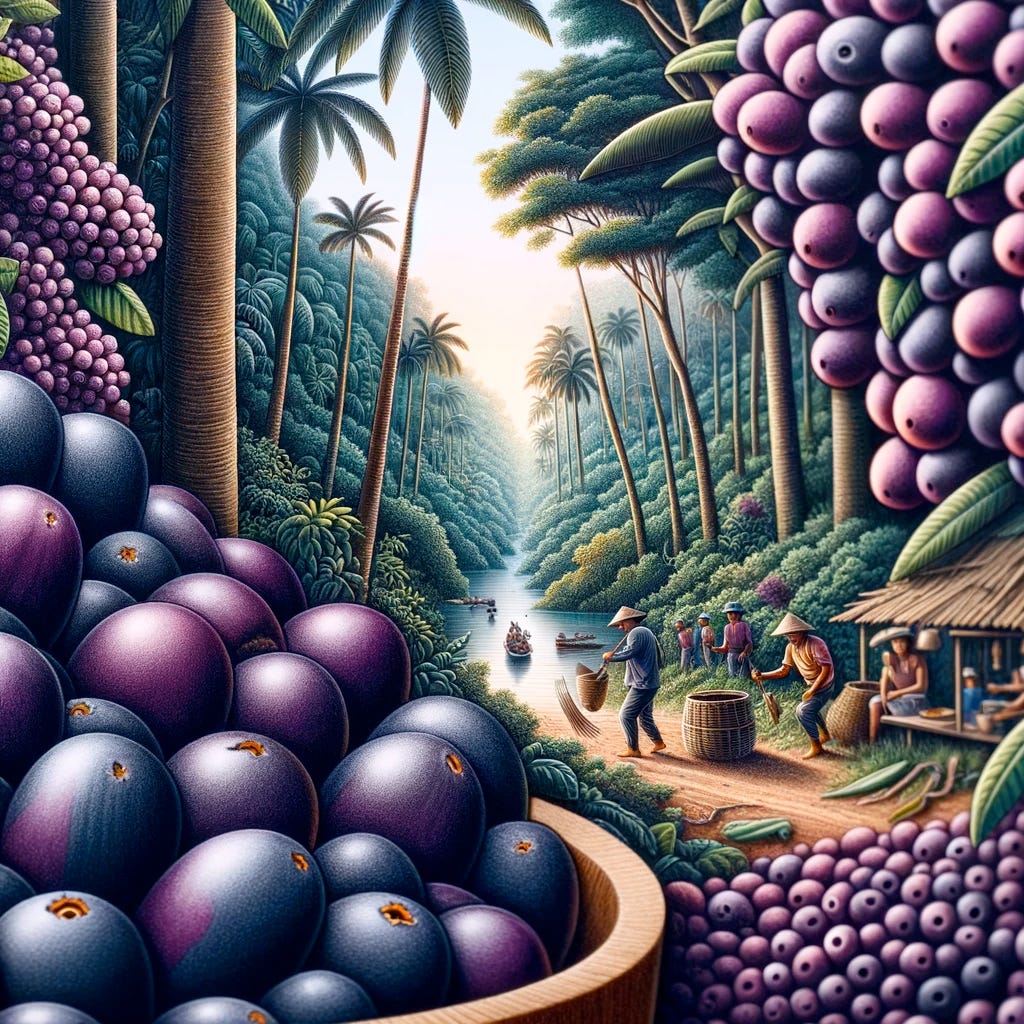So what is the Açaí Berry? And what does it taste like?
Deep in the Amazon rainforest grows the açaí palm tree, home to a small, dark purple berry that has taken the world by storm. The açaí berry has a unique, earthy flavor often described as a blend of rich chocolate and tart wild berries. Its creamy texture makes it a versatile ingredient for smoothies, bowls, and beverages.
But açaí is more than just a delicious treat. This little berry from the Amazon packs a powerful nutritional punch, loaded with antioxidants that have made it a celebrated "superfood" worldwide.
From Local Staple to Global Phenomenon
For centuries, the indigenous communities of the Amazon have relied on açaí berries as a dietary staple, prizing their nutrition. It wasn't until the 1990s that açaí started becoming popular globally when California surfers discovered the berry's energizing qualities.
Demand for the superfruit then exploded as word spread of its remarkable antioxidant levels, fiber, and healthy fats. Açaí rapidly transformed from a regional Amazonian delicacy into an internationally-coveted superfood.
While the açaí berry's rise to global prominence is a story of nutritional benefits and economic opportunities, it has not been without its darker side. Several scams have emerged around açaí, exploiting its superfood status. Unscrupulous marketers have made exaggerated claims about the berry's health benefits, from miraculous weight loss to curing diseases, often without scientific backing. These misleading promotions have not only confused consumers but also detracted from the genuine nutritional value of açaí. It's essential for consumers to approach açaí products with a critical eye and rely on reputable sources to avoid falling prey to these deceptive practices.
An Economic Boon for the Amazon
As global appetites for açaí intensified, the berry's trade provided a major economic boon for the Amazon region. At first, harvesting and selling açaí offered sustainable income that allowed forest communities to prosper while preserving the rainforest.
However, açaí's phenomenal growth also presents challenges. The accelerated production has strained land use and potentially threatens the area's biodiversity. Ensuring sustainable harvesting that balances economic opportunity with environmental protection has become crucial.
A Double-Edged Socioeconomic Impact
For Amazonian communities, açaí's globalization has ushered in socioeconomic changes both positive and negative. The açaí trade opened new income sources that elevated many families' standards of living. Yet it has also disrupted traditional ways of life and land usage.
While welcomed, the windfall of açaí wealth introduced complexities challenging long-held cultural practices. An over-reliance on this single cash crop also leaves communities vulnerable to market volatility and environmental instability.
The Way Forward
As açaí continues enticing the world's tastebuds, its incredible journey spotlights the intricate dynamics of introducing a local food crop to international markets. It underscores the importance of pursuing economic development while preserving environmental and cultural legacies.
For the Amazonian communities that introduced us to this superfruit, the path forward requires diversifying incomes, adopting sustainable practices, and ensuring açaí's prosperity equitably benefits all. Only through such balanced approaches can this remarkable little berry continue nourishing both rainforest communities and global smoothie lovers alike.
Additional Sources:
Brondízio, E. S., Safar, C., & Siqueira, A. D. (2002). The urban market of Açaí fruit (Euterpe oleracea Mart.) and rural land use change: Ethnographic insights into the role of price and land tenure constraining agricultural choices in the Amazon estuary. Urban Ecosystems, 6, 67-97.
https://link.springer.com/article/10.1023/A:1025966613562
Lima, V. M., Costa, S. M. F., & Ribeiro, H. (2018). Globalization and Health in a Small Town in the Amazon Region. Current Issues in Global Health. Access here.
Weinstein, S., & Moegenburg, S. (2004). Acai Palm Management in the Amazon Estuary: Course for Conservation or Passage to Plantations? Conservation and Society, 2, 315.
Pepper, L., & Alves, L. N. (2017). Small-Scale Açaí in the Global Market: Adding Value to Ensure Sustained Income for Forest Farmers in the Amazon Estuary. Access here.
Junior, J. M. D. S., Rebello, F. K., Lima, H., Santos, M. A. S., Santos, P. C., & Lopes, M. L. B. (2019). Socio-economics of Acai Production in Rural Communities in the Brazilian Amazon: A Case Study in the Municipality of Igarapé-Miri, State of Pará. Journal of Agricultural Science. Access here.





